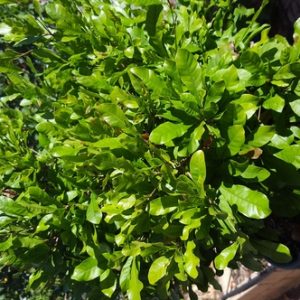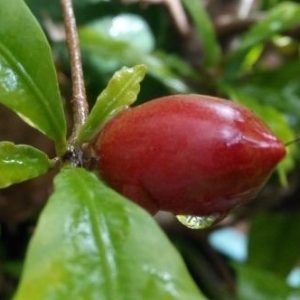Synsepalum (Richardella) dulcificum (dulcifica)
Miracle fruit, miracle berry
Origin
West Africa.
Climate
Warm, humid tropical or subtropical, but it does seem to adjust to cooler climates. Mature plants can tolerate a brief period of frost. If grown in a pot, it can be moved to a warm location during cold weather.
Plant Description
Bushy evergreen shrub to 4m tall. Foliage is dense with the alternate obovate–lanceolate leaves clustered near the terminals, 4-12cm long and 2-4cm wide.
Relatives
Member of the large Sapotaceae Family which also includes argan, abiu, star apple, sapodilla, canistel, lucuma and mamey sapote.
Soils
Acid, pH 4.5-5.8, and well-drained as there is little tolerance to alkaline conditions or waterlogging. Neutral soil may be acidified with powdered sulphur and mulched with peat moss.
Propagation
Seeds. Air layering and cuttings are possible, but usually do not grow well. Seeds must be fresh as they lose viability quickly. The recalcitrant seeds should be sown fresh in a rich well-drained medium, barely covered, and water lightly every day. Most will germinate in about 8 weeks. They grow slowly the first year, and may be only about 7 cm tall after one year.
It is best to keep the young seedlings in pots, repotting every year, until they are at least 35cm tall, before planting out.
Cultivars
Hirsutus is one superior variety but difficult to source in WA.
Flowering and Pollination
The small white axillary flowers are bisexual, solitary or in clusters of 2-4. The calyx is 5-lobed, 5mm long, ribbed with triangular lobes, and the white corolla is of similar length. Flowering can begin at the age of 3 years. Depending on conditions (nutrition, climate), they can flower almost continuously all year round. If pollination is not carried out by local insects, a small brush can be used to transfer pollen. From flower to fruit is a mere 3 to 4 weeks. The flowers produce a sweet perfume at night.
Cultivation
It prefers semi-shade or filtered sunlight. Keep an eye on the pH of the soil, and check it with a meter or with a soil-testing kit. Keep the soil moist and feed at least every ten days; little and often. Seasol and fish emulsion are good. If possible, use rainwater. They often react poorly to strongly treated scheme water.
Wind Tolerance
They prefer a sheltered location.
Pruning
Light pruning to shape the plant to an appropriate shape and size. It also stimulates branching and the production of more flowers.
The Fruit
It is an ovoid-oblong berry, 2-2.5cm long by 1cm wide, very finely pubescent with a protruding style and skin turning from green to bright red when mature. It contains a single dark brown ellipsoid seed surrounded by the fleshy white-translucent insipid pulp. The berry has the ‘miraculous’ effect of transforming sour (ie acid) flavour to sweet. It has very little intrinsic sweetness, but a contained protein (miraculin) binds to sweet receptors on taste buds which enable food acids (primarily citric acid) over the next 1-2hrs to stimulate them, resulting in the sensation of sweetness.
Fruit Production and Harvesting
Plants may begin fruiting when about 4 years old and it only takes 3-4 weeks from fruit set to maturity.The main crops come in winter, with larger plants tending to bear some fruit most of the year. As the seed is large and the flesh scanty, they are not used for jams, juice or desserts. They can be frozen, with no loss of quality, so most people simply pick a few as they become ripe, often, and put them in a container in the freezer.
Fruit Uses
Used fresh or frozen to obtain the sour-to-sweet transformation.
Pests and Diseases
Nematodes, scale. Do not treat the scale with white oil, as it causes leaf drop.
Comments
Miracle fruit plants are very well suited for growing in a pot. It is easier to control the special conditions they require – acidity, moisture and sun exposure.
It has been the basis of a party trick – a berry is given to someone to taste without any ceremony. Later, after declaring that a certain lemon is ‘the sweetest in the world’ it’s given to the unsuspecting person and surprise, surprise, it really does taste sweet without any of the normal sourness! More seriously, as a no-calorie substitute for sugars and one that doesn’t trigger insulin release, it has been proposed as an alternative flavour enhancer in processed foods, and also for persons undertaking chemotherapy treatment, where typically these drugs distort or degrade perceived food flavours, often with negative nutritional consequences. One berry is sufficient to give the effect – more does not increase the effect. This property is destroyed if the fruit is heated.

